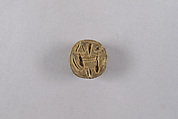Round Seal Inscribed with Bessing Related to Bastet
Third Intermediate Period
This round seal with domed back displays on its underside hieroglyphs and a monkey holding a nefer hieroglyph. The entire inscription reads as a blessing related to the goddess Bastet.
Scarabs bearing wishes and blessings related to divinities whose protection individuals wished to summon are particular popular during the late New Kingdom and the Third Intermediate Period (ca. 1295-664 B.C.). Given the limited surface on scarab bases, seal carvers were often very creative in using as few hieroglyphs and signs as possible in order to convey their message.
The goddess Bastet is here referred to by the vase which is used to write her name in hieroglyphs. The presence of the monkey is explained by the fact that, as a hieroglyph, it can also have the phonetic value nefer, which means good and beautiful. The monkey thus reinforcing the already present nefer sign in its hands. The monkey holding nefer is therefore a motif that bestows upon the owner of the seal-amulet a multitude of good things.
Due to rights restrictions, this image cannot be enlarged, viewed at full screen, or downloaded.
This artwork is meant to be viewed from right to left. Scroll left to view more.





